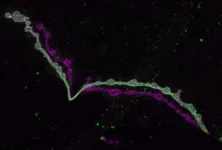(Press-News.org) Figuring out how hundreds of different kinds of brain cells develop from their unique expression of thousands of genes promises to not only advance understanding of how the brain works in health, but also what goes wrong in disease. A new MIT study that precisely probes this “molecular logic” in two neuron types of the Drosophila fruit fly, shows that even similar cells push and pull many levers to develop distinct functions.
In the study in Neuron, a team of neurobiologists at The Picower Institute for Learning and Memory found that the two closely related neuronal subtypes differed from each other in how they expressed more than 800 genes, or ~5% of the total genes encoded in the fly genome. By manipulating genes whose expression differed most prominently, the scientists were then able to show how they produced several of the observable differences between the cells.
“There is a global effort in neuroscience to identify all the different types of neurons to define their unique properties and their gene expression profiles,” said study senior author Troy Littleton, Menicon Professor of Neuroscience in MIT’s Departments of Biology and Brain and Cognitive Sciences. “That information can be used as a toolkit for studying how newly found disease genes map on to those particular neurons to indicate which ones might be most affected in specific brain disorders.
“We wanted to use Drosophila as a way to see whether we can, in fact, determine how the transcriptome of two similar neurons is differentially used to understand which key genes specify their unique structural and functional properties.”
Under the microscope
The two neuron types compared in the study both emerge from the fly’s analog of a spinal cord to control muscles by releasing the neurotransmitter glutamate at connections called synapses. The neurons’ main functional differences are that “phasic” neurons connect to many muscles and emit big, occasional bursts of glutamate while “tonic” neurons each connect to only one muscle and provide more of a constant drip of the chemical. This duality, which is also found in neurons of the human brain, provides a flexible range of control.
Picower Institute postdoc Suresh Jetti led the effort in Littleton’s lab to determine how these two neurons develop their differences. The team began with an unusually deep characterization of how the two cell types differ in form and function and then took a highly precise look at the gene expression profiles, or transcriptomes.
On close examination, the tonic and phasic cells showed a variety of important differences. Phasic neurons make fewer synapses on an individual muscle than tonic ones do, but because they innervate so many more muscles, phasic neurons have to make about four times as many synapses in total. The tonic neurons have more inputs from other neurons thanks to more widely reaching dendrites (the branches that lead into the cell). On the output side of things, the phasic neurons produced much more powerful signals when stimulated and were more likely to send them than tonic neurons were. Analysis showed that the synaptic sites that prompt glutamate release, called active zones (AZs), took in more calcium ions in phasic neurons than tonic ones.
A particularly new and intriguing finding was that the AZs in tonic and phasic neurons took on different shapes. Tonic AZs were round, like donuts, while phasic ones were more triangular or star-shaped. Littleton hypothesizes that this difference could allow for more calcium ions to crowd into the phasic active zones, perhaps explaining their greater bursts of glutamate release compared to tonic neurons.
Expressing their differences
To assess gene expression, Jetti employed a technique called “isoform patchseq” in which he identified the exact same tonic and phasic neurons in hundreds of flies and extracted RNA from their individual nuclei and cell bodies. The technique, while very hard work, provided the team with an unusually rich vein of transcriptomic information from precisely the cells of interest, Littleton said, including not only how gene expression differed between the two cell types, but also how gene splicing and RNA editing were different.
In all, the expression of 822 genes was significantly different between the two neuron types. About 35 of the genes were known to help guide the growth of the axon branches that neurons extend to forge their connections with muscle – a set of differences pertinent to why tonic neurons innervate only one muscle while phasic ones innervate many. Other differentially expressed genes related to the structure and function of synapses, while more than 20 others suggested differences in the neuromodulatory chemicals each neuron was sensitive to as inputs.
The team found that transport proteins were more prominently expressed in phasic neurons, perhaps explaining how they keep up with the greater demand to forge more synapses across many muscles. The team also found that while tonic neurons express “sialylation” genes to attach sugars to proteins on their synaptic membrane, phasic ones expressed unique “ubiquitin” genes that break down proteins.
After documenting which genes were most prominently different, the team set out to determine what they do by disrupting their function and seeing how that affected the cells.
For instance, Jetti, Littleton and colleagues found that interfering with specific ubiquitination genes caused phasic neurons to overgrow synapses. Disrupting sialylation, meanwhile, caused synaptic undergrowth in tonic neurons. Tonic neurons also expressed 40 times more of a gene called Wnt4, and disrupting Wnt4 reduced synaptic growth in this population of neurons.
The scientists had also found that phasic neurons express a calcium-ion buffering gene >30-fold more than tonic ones. When they mutated that gene to disrupt its function, they found that phasic neurons, which normally have lower baseline calcium levels, now display higher resting calcium similar to the tonic neurons.
And in another experiment they showed they could distinctly disrupt each cell’s AZ shapes by interfering with cytoskeletal genes that each neuron expressed especially highly. When the team reduced a gene that phasic neurons express a lot, their AZs became elongated, but tonic AZs were unaffected. When the team reduced a gene that phasic neurons highly express, their AZs became less round without affecting AZs in phasic cells.
In all, the analysis enabled the team to begin constructing a model of the molecular differences that make the two cells differ, though Littleton said they still have more work to understand how the full repertoire of gene expression differences define the unique properties of the two neuronal subtypes.
In addition to Littleton and Jetti, the paper’s other authors are Andres Crane, Yulia Akbergenova, Nicole Aponte-Santiago, Karen Cunningham, and Charles Whittaker.
The JPB Foundation, The Picower Institute for Learning and Memory, and the National Institutes of Health funded the research.
END
Study connects neural gene expression differences to functional distinctions
2023-08-23
ELSE PRESS RELEASES FROM THIS DATE:
Toppling siloes to link electronic dental and health records
2023-08-23
INDIANAPOLIS – A new study from researchers at Regenstrief Institute and Indiana University School of Dentistry reports on linking electronic health records and electronic dental records to provide better care and outcomes for individuals with Sjögren's disease, an autoimmune disorder that can affect the entire body, including teeth. Their work may have implications for other systemic autoimmune diseases, including lupus and possibly rheumatoid arthritis.
Sjögren’s is a chronic autoimmune connective tissue disorder affecting four million Americans ...
AI recommendation vs. user subscription: analyzing in-feed digital advertising performance on platforms like Twitter, Google News, and TikTok
2023-08-23
Researchers from Lehigh University, University of Hong Kong, and Wuhan University published a new Journal of Marketing article that examines in-feed advertising’s performance across subscription versus AI recommended news feeds.
The study, forthcoming in the Journal of Marketing, is titled “Tales of Two Channels: Digital Advertising Performance Between AI Recommendation and User Subscription Channels” and is authored by Beibei Dong, Mengzhou Zhuang, Eric (Er) Fang, and Minxue Huang.
How ...
Crystal S. Denlinger, MD, FACP, named new CEO of National Comprehensive Cancer Network; Robert W. Carlson, MD, retiring after 10+ years leading global oncology nonprofit
2023-08-23
PLYMOUTH MEETING, PA [August 23, 2023] — Today the National Comprehensive Cancer Network® (NCCN®)—a not-for-profit alliance of leading academic cancer centers—announced Crystal S. Denlinger, MD, FACP, as incoming Chief Executive Officer (CEO). Dr. Denlinger—who is currently NCCN’s Senior Vice President, Chief Scientific Officer—is being promoted to lead the global guidelines organization following a national search to replace the retiring longtime CEO, Robert W. Carlson, MD.
Dr. Denlinger has a long history of global cancer care leadership with NCCN and beyond. She was named an ...
Matthew Sfeir named 2023 Moore Foundation Experimental Physics Investigator
2023-08-23
NEW YORK, August 23, 2023 — Physicist Matthew Sfeir is among 21 innovative mid-career scientists who will each receive $1.25 million from the Gordon and Betty Moore Foundation to pursue experimental physics research with the promise of significantly transforming understanding of physics and facilitating next-generation technological breakthroughs.
The five-year Experimental Physics Investigator Award will allow Sfeir—a Photonics Initiative professor with the Advanced Science Research Center at the CUNY Graduate Center (CUNY ASRC) ...
Despite fears to the contrary, Canadian wildfire smoke exposure was not much worse than a bad pollen day in New York City
2023-08-23
New Yorkers can apparently breathe a sigh of relief, at least for now. Their exposure to the smoke in June 2023 from Canadian wildfires led to only a slightly higher bump in visits to New York City hospital emergency departments for breathing problems or asthma attacks than what is seen on days when pollen counts are high. However, authors of a new study say other possible health effects, such as possible heart attacks and stroke, still need to be investigated.
For the study, researchers at NYU Grossman School of Medicine analyzed daily levels of air pollution, as measured ...
Rare kidney disease is genetically decoded
2023-08-23
When Dr. Bodo Beck first saw the three children of a family who had fled Syria sitting in his consultation room at University Hospital Cologne, the human geneticist was surprised. His genetic analysis diagnosed Bartter syndrome type 3, but never before had he seen such severe joint changes in patients with this rare disease.
The kidney disease is hereditary – affected individuals lack the CLCNKB gene, which is responsible for a specific chloride channel. The electrolyte balance becomes disrupted because the kidneys cannot reabsorb important nutrients and salts back into ...
Which is better—casts or surgery—for older adults with arm fractures?
2023-08-23
A recent study in the Journal of Orthopaedic Research found that cast immobilization is as effective as surgery for treating older patients with bone fractures near the wrist.
The study included 276 patients aged 70–89 years who suffered a distal radius fracture that didn’t penetrate the skin and that was treated conservatively or surgically between August 2018 and January 2022. Cast immobilization was used on 213 patients, whereas the other 63 had plates or pins placed during different types of surgery.
Nineteen patients experienced complications within the first year, with the most common being complex regional pain syndrome (5 patients who ...
Is research adequately assessing mental health interventions for children in low- and middle-income countries?
2023-08-23
It is estimated that, globally, mental disorders affect about one in seven children and adolescents aged 10–19 years. A recent analysis of published studies indicates that most research on child and adolescent mental health and psychological interventions in low- and middle-income countries is reactive rather than proactive, focusing on treating rather than preventing mental health problems or promoting mental health.
For the analysis, which is published in Campbell Systematic Reviews, investigators searched a wide range of bibliographic databases, libraries, and websites for relevant studies published between 2010 and ...
Study assesses lifestyle behaviors and cardiometabolic diseases in diverse group of US young adults
2023-08-23
Research published in the Journal of the American Heart Association reveals that many US young adults have poor lifestyle factors and cardiometabolic diseases—such as obesity, diabetes, and hypertension—with varying rates based on race and ethnicity.
The study included 10,405 individuals aged 18–44 years whose information was available from the National Health and Nutrition Examination Survey, 2011–2018. The prevalence of lifestyle risk factors ranged from 16.3% for excessive drinking to 49.3% for poor diet quality. The prevalence of cardiometabolic ...
Does deafness alter brain circuits supporting social skills?
2023-08-23
Hearing impairment may cause difficulties in social interactions, but new research indicates that social struggles experienced by deaf individuals are likely not due to brain alterations but rather due to non-supportive environments. The findings, which are published in Human Brain Mapping, suggest that deafness does not affect the mechanisms and brain circuits supporting social skills.
For the research, investigators analyzed published neuroimaging studies focusing on social perception in deaf versus hearing participants. Results indicated that both deaf and hearing participants recruited the ...



